|
T:-)M's Night Shift More Miles Than Money |
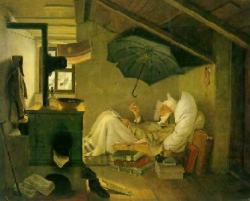
|
FolkWorld Issue 42 07/2010; Book Reviews by Walkin' T:-)M
|
T:-)M's Night Shift More Miles Than Money |

|
|
|
Music in Motion was the theme of last edition's Night Shift. It might be opposed to this column's idea of whiling away the night hours with a couple of good books, but essentially this is what music and musicians are all about. So let's hit the road Kerouac-style with Garth Cartwright, Bob Dylan and Christine Lavin.
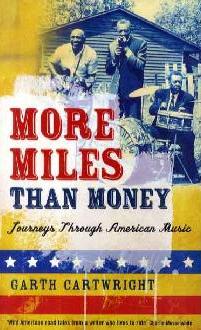 Garth Cartwright, More Miles Than Money - Journeys Through Ameri-can Music. Serpent's Tail, 2009, ISBN 978-1-84668-687-0, pp380, £12.99. |
After criss-crossing the Balkans (FW#37), Garth Cartwright set out for a quest from Las to Nashvegas, listening out for good music and trying to take freedom's pulse. He started out at the only temple on earth dedicated to the worship of John Coltrane as a latter-day saint, he visited black ghettos and Mexican barrios, he rode Greyhound buses and the City of New Orleans, he travelled on Route 66 and on Highway 61.
He was experiencing More Miles Than Money (a song lyric by American-Mexican singer-songwriter Alejandro Escovedo): I found ruin and beauty, openness and intolerance, despair and hope.
Garth held a life-long fascination for American music: specifically the stuff made by the nation's most marginal citizens celebrates the twentieth century's inclusive genius, the people's spirit, like nothing else.
He meets and speaks with musicians, but encounters the first decent live music on page 101, when R&B man Charles Wright is rehearsing at his home. The first decent concerts occur later - with country artists Dale Watson and his Lone Stars and Billy Joe Shaver.
Instead there is muzak, musical pap, Botox music, a tinny squeak of sound, and decent artists virtually have become an endangered species: today finding a porn store is much easier than finding a record shop, and even the greater black community tends to think of blues as Uncle Tom shit.
Garth's travelogue is an eye-opening journey into McAmerica, and oftentimes it doesn't make fun - actually it rarely makes fun.
It's not the lack of a left perspective that offends me but the loss of vision and soul in a music once offering plenty of both. Music Row now ensures songs get flossed, made over until all the dirt, pain and grit are removed.
A lof of the musicians are elderly people, and Garth finds only little hope:
[Diana Jones] tries to explain why she and a growing number of other young musicians are making music that harks back to pre-Elvis Southern music. Call it folk or country or old timey or whatever but this is what I feel natural doing. I like its honesty and down-to-earth quality. Not that getting heard is easy: Deregulation brings us Hot New Country radio. Luckily, there's lots of festivals and small venues that like the kind of music we make and a big interest across the US among people of my generation.
Garth cites Little Jack Horton at the beginning, but I think it should be rather read as instructions to act:
We can't let the goddamn country go down to politicians and corporate madmen and media people and college professors, run it over and ruin it all. It's ours, our goddamn country. You know, goddamn, Ronald Reagan died recently and they flew the flag half-mast. Well, did they fly it at half-mast for Ray Charles? For Johnny Cash? Declare a national holiday? Yet these people moved and changed the daily lives more than any politician who are just grifters and scum. So let us now praise the real American heroes, the ones with heart and soul who changed things for the good.
A CD compilation of the music covered is forthcoming, meanwhile I suggest to read his Balkan book "Princes Amongst Men" (#37), More Miles can only be second choice.
The cult that surrounds Robert Zimmerman, obsessive fans poring over his every utterance, is reprehensible, the kind of idle idol worship we sneer at when exhibited by religious fanatics. But when 'Like a Rolling Stone' kicks off I chuckle over how loud, obnoxious music can sound so good. I quickly decide Dylan's not great road music (too many words, too many uneven songs) and, concentrating on changing songs, I almost joined Highway 61's fabled list of road carnage.
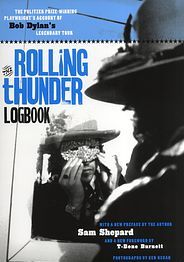 Sam Shepard, The Rolling Thun-der Logbook. Bobcat Books, 2010, ISBN 978-1-84938-251-9, pp179, £14.95. |
A place Garth did not visit was the Northeast of the USA, where Bob Dylan and an entourage including Joni Mitchell (#41), Joan Baez (#42), Arlo Guthrie (#34) and many many more, toured in a strike-and-retreat-style in the autumn of 1975. Dylan's raggle-tagle gypsy show became famous as the - Rolling Thunder Revue.
Dylan's back-up band was a collection, each member looking like a whole band could be built around him, the maestro being in the eye of a hurricane:
Tonight Dylan appears in a rubber Dylan mask that he'd picked up on 42nd Street. The crowd is stupefied. A kind of panic-stricken hush falls over the place. Has he had another accident? Plastic surgery? Or is this some kind of mammoth hoax? An imposter! The voice sounds the same. If it is a replacement, he's doing a good job. He goes through three or four songs with the thing on, then reaches for the harmonica. He tries to play it through the mask but it won't work, so he rips it off and throws it back into the floodlights. The audience is totally bewildered and still wondering if this is actually him or not.
Madness it is. Roger McGuinn (#23)
explains that it wasn't until the past year or so that he's managed to get over a profound fear of being assassinated on stage. He'd be singing with the Byrds and all through the song he'd be imagining the hands of the gunman as they polished the barrel with a chamois skin and then the black barrel of the rifle sweeping the width of the stage trying to find the correct angle. Sometimes the bullet would find him and he'd go right down, but the crowd would only think that he'd fainted, since they couldn't hear the shot over the sound of the music. Or sometimes the bullet would glance off the guitar and strike some other member of the band. Or sometimes the bullet would miss him altogether. In any case, he's still alive and kicking.
Playwright Sam Shepard was hired to write the script for a Carné-Truffaut-like movie that would come out of the tour.
We've abandoned the idea of developing a polished screenplay or even a scenario-type shooting script, since it's obvious that these musicians aren't going to be knocking themselves out memorizing lines in their spare time. They're either rehearsing all night, playing a concert, or jamming, and then crashing out about six or seven in the morning.
The film never materialized - the whole thing is a booming event beyond film, beyond tape recorders, beyond any attempt to capture the whole of it, there's no way to even document this thing - instead Sam Shepard wrote the Pulitzer prize-winning The Rolling Thunder Logbook.
 |
This updated edition is supplemented with photographs by tour still photographer Ken Regan, a Subterranean-Homesick-Blues-like preface by Shepard, and a foreword by The Lonesome Guitar Strangler T-Bone Burnett.
Shepard's logbook was never meant to be a full account of the tour, which would have been pretty boring, but rather trying to recreate the atmosphere while on the road with a patchwork chronicle. This popular book might become even more popular, though I confess it is not my cup of tea. Shepard's writing is often an enigma, but that's fitting, Dylan being one too.
In 1975 Christine Lavin was waitressing at the Caffé Lena in Saratoga Springs, New York:
[Lena Spencer] had gotten word that Bob Dylan was putting together a special 'bicentennial tour'. Rumor had it they were not going to play large venues, just small ones. Lena, bless her heart, wanted them to play the Caffé. Lena, with all her grit and determination, got the number for a Massachussetts motel that might be the place where the musicians were. She asked if we'd be willing to go on a road trip with her, and we said yes.
For the next three days we got to be part of the Dylan entourage and were able to watch a few of the performances. The tour was loosely organized - there were three big buses, a dozen or so cars, and a couple of trucks. We were just told to follow the buses. After stopping at one rest stop, the buses got back on the highway going in the wrong direction, with all of us following. When they realized what they'd done, the buses all made a huge, wide U-turn in the grass to cross over the highway and go the other way.
On Thursday afternoon, Bob Dylan and some of his friends made a side trip to visit the grave of Jack Kerouac, author of 'On the Road'. We all pulled into a rest stop along the interstate and went into the restaurant. I tried to think of something to say, so I blurted out, I love how you end the show with 'This Land Is Your Land' - it's a nice touch how everybody takes a different verse. Thanks, he said, fidgeting. I asked him if he had heard the Native American verse that Pete Seeger had been singing. No, Bob responded. How does it go?
This land was your land, it was not my land
Until you sold us Manhattan Island
We pushed your Nations to the reservations
This land was swiped from you by meWow, I like it, he said. Then he got up from the table. So that was my one and only conversation with Bob Dylan. I was hoping he would say something wise that I would remember forever, but instead I told him how a song went.
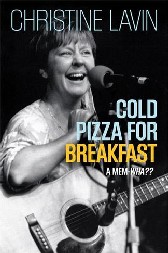 Cristine Lavin, Cold Pizza for Breakfast - A Mem-wah??. Tell Me Press, 2010, ISBN 978-0-9816453-6-0, pp345, US$21.95. |
Christine worked at the coffehouse until Dave Van Ronk (#32) convinced her to move to New York City and pursue a career as a singer-songwriter. She followed his advice and accepted his offer of guitar lessons.
Let's make a quick jump back in time: as a kid Christine was taught piano, when being 12 years of age she watched guitar lessons on TV, with 13 she started writing her own songs. It was in the magic year of 1975, when she became a touring musician in - of all places - Clear Lake, Iowa, where Buddy Holly's plane crashed and killed him. Christine was singing at elementary schools:
[My agent] had assured all the schools that if they didn't like me, they would get their money back. I did fifty shows in five weeks, and only one school asked for a refund. That school was in Ohio, where the principal who introduced the show warned the students that they weren't allowed to applaud because the sound is very disruptive to performers. He also told them they weren't allowed to laugh. It was like performing in a children's prison, under the watchful eye of the mean old warden. The principal subsequently rated my performance unsatisfactory; no one enjoyed it, he said.In 1981 she recorded her debut album, more were to follow, including a cookbook project for Appleseeds Recordings in 2006 (#32).
Christine Lavin's memoir Cold Pizza for Breakfast kicks off with elderly Florida residents booing her off the stage. Well, is it a good idea to sing "Bald Headed Men" to men wearing shiny black toupees?
I became aware that the bright stage lights were bouncing off my shiny guitar and then hitting the audience in the eyes. Some were shading their eyes with their hands, some with their programs. I tried to move in such a way that I wasn't constantly hitting the same people in the eyes over and over again. When that song was done, to barely any applause I said: I know I'm moving sort of spaz-like onstage. It's because I can see the stage lights are hitting my guitar, then hitting some of you in the eye. I'm moving like this because I am trying to blind you all equally.
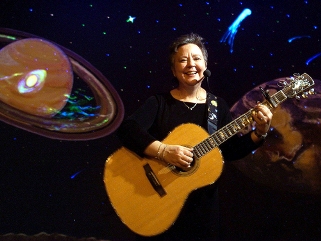 |
These stories are in line with the kind of songs Christine is writing, often if not mainly humorous and amusing. I will give you some examples here, e.g. the one about Prince Charles and Lady Di (as is so often it is not that funny for those concerned):
|
Oh Charles, my Charles Any girls looks good when she's nineteen But think about her thirty years from now When she's an old and ugly queen Ooh - take a look at your mother, boy And you'll know what I mean |
The next one had been written before Michael Jackson left Planet Neverland for good and all, but it is an well-known story for artists:
|
Record companies love it When their recording artists die They get to re-release all the albums That never sold back in July Well I don't have any records But I know the soundman's making a tape And in three months he'll be bootlegging copies For $7.98 |
This lady is a real character and a born storyteller. Christine has experienced more than others in her life, or has a better memory. At times it is hilarious, even if it comes to the ups and downs of a performing artist. A chapter is dedicated to stupidly crappy mind-numbing music business disappointments, but even then it's witty and funny. Besides this book is a kind of DIY kit for upcoming songwriters who want to perform. Then this book is a real treat, you don't even have to know (save like) her music.
Christine met her share of interesting people, including Utah Phillips (#39), Tom Paxton (#35), Rosalie Sorrels (#31), Nanci Griffith (#39), Michelle Shocked (#24), James Keelaghan (#40), David Francey (#30), Rod Picott (#31), Archie Fisher (#40), and many more I'd never heard of. It is a nice touch when she says regarding the book's index: I encourage you to google every single name listed there. You might make some life-changing musical discoveries...
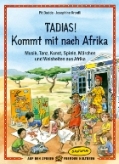

|
|
To the German FolkWorld |
© The Mollis - Editors of FolkWorld; Published 07/2010
All material published in FolkWorld is © The Author via FolkWorld. Storage for private use is allowed and welcome. Reviews and extracts of up to 200 words may be freely quoted and reproduced, if source and author are acknowledged. For any other reproduction please ask the Editors for permission. Although any external links from FolkWorld are chosen with greatest care, FolkWorld and its editors do not take any responsibility for the content of the linked external websites.
